A glossary of terms, commonly used in discussing pinball machines.

Pin-Bot is a pinball machine released by Williams in October 1986. It was designed by Python Anghelo and Barry Oursler.
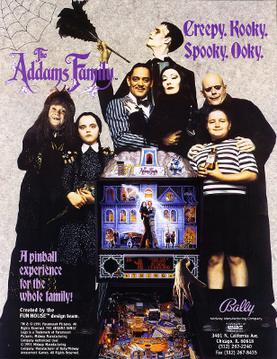
The Addams Family is a pinball machine released in March 1992. It was designed by Pat Lawlor and Larry DeMar and released by Midway. It was based on the 1991 film of the same name, and features custom speech by the stars of the film, Anjelica Huston and Raul Julia. It is the best-selling solid state pinball machine of all time with 20,270 units sold.

Star Trek: The Next Generation is a widebody pinball game, designed by Steve Ritchie and released in November 1993 by Williams Electronics. It was part of WMS' SuperPin series, and was based on the TV series. It is the only pinball machine that features three separate highscore-lists. Apart from the regular highscore-list and the buy-in-list, it also features a reminiscence to The Machine: Bride of Pin*Bot billionaires club. It is also the third pinball game overall based on the Star Trek franchise, following the 1979 pinball game by Bally, and the 1991 game by Data East, and preceding the 2013 pinball game by Stern.
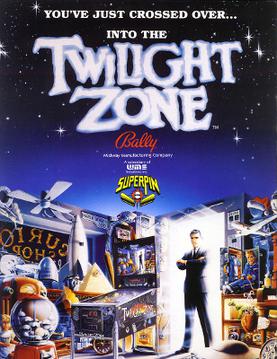
Twilight Zone is a widebody pinball machine, designed by Pat Lawlor and based on the TV series of the same name. It was first released in 1993 by Midway. This game is part of WMS' SuperPin line of widebody games alongside Star Trek: The Next Generation and Indiana Jones: The Pinball Adventure.

Cirqus Voltaire is a 1997 pinball game, designed by John Popadiuk and released by Williams Electronics Games. The theme involves the player performing many different marvels in order to join the circus. Some of the game's distinctive features include a neon light running along the right-hand ramp, a pop bumper that rises up from the middle of the playfield at certain times, and a magnet at the top of the left ramp that can catch balls and divert them into the locks. The most notable feature is the Ringmaster, a head that rises at certain times and taunts the player.
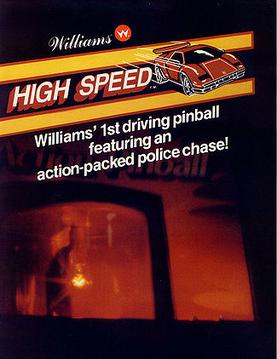
High Speed is a pinball game designed by Steve Ritchie and released by Williams Electronics in 1986. It is based on Ritchie's real-life police chase inside a 1979 Porsche 928. He was finally caught in Lodi, California on Interstate 5 and accused of speeding at 146 miles per hour (235 km/h).

The Getaway: High Speed II is a 1992 pinball game by Steve Ritchie. It is a sequel to 1986's High Speed.
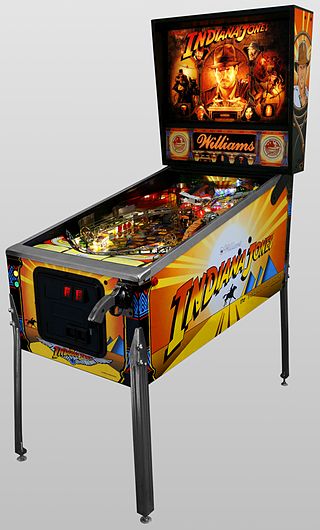
Indiana Jones: The Pinball Adventure is a 1993 widebody pinball game designed by Mark Ritchie and released by Williams. It was based on the Indiana Jones movies. It was also part of WMS' SuperPin series of widebody games.
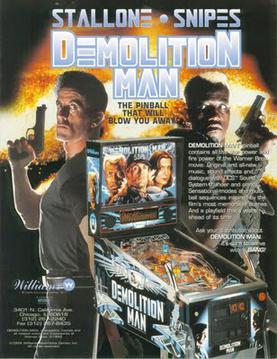
Demolition Man is a Williams pinball machine released in February 1994. It is based on the motion picture of the same name. It is part of WMS' SuperPin line of widebody games.

Fish Tales is a fishing-themed pinball game released by Williams in 1992. It is one of the top 20 most produced pinball machines of all time, selling more than 13,000 units.

Space Jam is a 1996 pinball machine released by Sega Pinball. It is based on the film of the same name.

Star Wars Episode I is a 1999 pinball game designed by John Popadiuk and released by Williams and the second machine to use the Pinball 2000 hardware platform. It is based in the Star Wars film The Phantom Menace.

Creature from the Black Lagoon is a pinball machine designed by John Trudeau and released by Midway. It is loosely based on the movie of the same name. The game's theme is 1950s drive-in theater. The pinball game was licensed from Universal Studios by Bally so that all backglass and cabinet artwork and creature depictions would resemble those of the original movie.
There have been four pinball adaptations of the film Jurassic Park franchise: a physical table released by Data East the same year the film came out, Sega's 1997 The Lost World which is based on the second movie of the series, a virtual table developed by Zen Studios on the franchise's 25th anniversary and a new physical table released by Stern Pinball a year after. All four tables behave differently.

Mary Shelley's Frankenstein is a 1995 pinball machine released by Sega Pinball. It is based in the film of the same name.

Jack-Bot is a 1995 pinball game which was designed by Barry Oursler and Larry DeMar, and released by Williams. It is the third game in the Pin-Bot series, following Pin-Bot (1986) and The Machine: Bride of Pin-Bot (1991).

Who Dunnit is a Midway pinball machine with a 1940s style and a murder mystery theme. The playfield features up to five different murder mysteries by revealing clues by sending the ball to an elevator, phone, or slot machine. The machine accepts up to four players, and features four-ball play.

Comet is a pinball machine released by Williams in June 1985. It was designed by Barry Oursler, who was inspired by the Comet roller coaster at Riverview Park in Chicago, and was the first in an amusement park themed pinball trilogy followed by Cyclone in 1988 and Hurricane in 1991.

Hurricane is a pinball machine released by Williams Electronics in August 1991. It was designed by Barry Oursler as the third game in Oursler's amusement park themed pinball trilogy. The first being Comet, released in 1985, and the second being Cyclone, released in 1988.




















